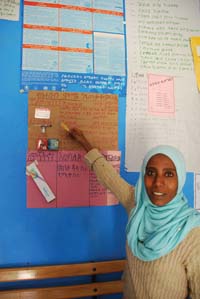10.1.2 Lecture
You may have the opportunity to give a lecture, perhaps in your local school or in another formal setting. A lecture is usually a spoken, simple, quick and traditional way of presenting your subject matter, but there are strengths and limitations to this approach. The strengths include the efficient introduction of factual material in a direct and logical manner. However, this method is generally ineffective where the audience is passive and learning is difficult to gauge. Experts are not always good teachers and communication in a lecture may be one-way with no feedback from the audience.
Lecture with discussion
You may have the opportunity to give a lecture and include a follow-up discussion, perhaps in a local formal setting or during a public meeting (Figure 10.3).

However there are also strengths and limitations to this approach. It is always useful to involve your audience after the lecture in asking questions, seeking clarification and challenging and reflecting on the subject matter. It’s important though to make sure discussion does happen and not just points of clarification.
10.1.1 Health talks
